ex libris — books that we like
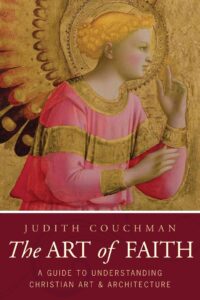 The Art of Faith: A Guide to Understanding Christian Images
The Art of Faith: A Guide to Understanding Christian Images
by Judith Couchman
Paraclete Press, Brewster, Massachusetts
ISBN 978-1-55725-630-0
ABOUT FAITH This book was written to help Christians who want to enrich their faith by deciphering and interpreting visual images and symbols used in religious paintings, sculpture, and stained glass windows. It translates the language of color and form used in Christian art through the centuries. The book includes historical information as well as helpful black-and-white drawings.
“This was the catalyst for Christian art: wanting to see Christ’s face. Whether we believe these ancient “face stores” as actual or legendary, they highlight the desire to visually witness the sacred. Consequently, early Christian artists began creating images of Jesus to help people accept, follow, and celebrate their new-found beliefs. They illustrated signs, symbols, saints, biblical stories, liturgical objects, and church furnishings to pass along their spiritual perspective and heritage.”
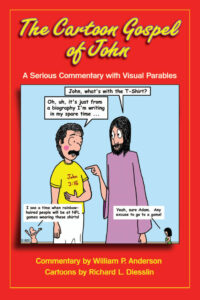 The Cartoon Gospel of John
The Cartoon Gospel of John
commentary by William P. Anderson
cartoons by Richard L. Diesslin
ACTA Publications, Chicago, Illinois
ISBN 0-87946-273-6
ABOUT THE GOSPEL ACCORDING TO JOHN In the Gospel According to John, the Evangelist describes memorable events that teach about Jesus. The Cartoon Gospel of John uses cartoons based on the Scripture to visually accomplish the same thing, highlighting the meaning of the Gospel According to John in unforgettable ways. Combined with written commentary, the colorful cartoons in this book provide an amusing yet serious approach to the Fourth Gospel. Although William Anderson and Richard Diesslin both have advanced backgrounds in theology, the cartoons in their small book sidestep cumbersome academic language.
“No, no. That’s PARACLETE, not PARAKEET. I’ll be sending you the Holy Spirit!” (from one of the cartoons)
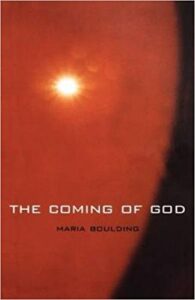 The Coming of God
The Coming of God
by Maria Boulding
The Printery House of Conception Abbey, Conception, Missouri
ISBN 0-9701865-1-7
ABOUT THE SPIRITUAL LIFE Praised by monastics for its spiritual depth, The Coming of God is an exploration of the many ways in which God comes to us—through events, other people, and prayer. Based on the author’s years of experience practicing the art of lectio divina, The Coming of God serves as a credible guide for others who don’t want to fail to recognize the presence of God in their lives.
“We have to wait in obedience, listening with an obedient heart to the Father’s word, because only the obedient heart can truly listen. If we have reservations, areas in our lives into which we are unwilling to admit God, we shall not be able to hear. The root of our prayer and of our whole life with God is an unconditional ‘Yes’ that does not necessarily understand all the time what is going on, but is still given.”
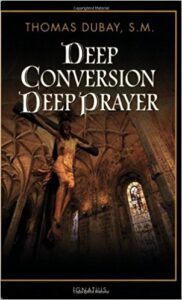 Deep Conversion / Deep Prayer
Deep Conversion / Deep Prayer
by Thomas Dubay, S.M.
Ignatius Press, San Francisco, California
ISBN 1-58617-117-8
ABOUT THE SPIRITUAL LIFE Deep Conversion/Deep Prayer addresses problems frequently encountered by those who attempt to devote a significant amount of time and energy to the quest for holiness. By the author of The Fire Within, a classic work on contemplative prayer based on the writings of St. Teresa of Avila and of St. John of the Cross, Deep Conversion/Deep Prayer offers encouragement and practical advice for overcoming obstacles that stand in the way of spiritual advancement. In words that are particularly applicable to the practice of lectio divina, the author stresses the need for serious commitment to daily meditative and contemplative prayer.
“We come now to the taproot of our surefire program: intimacy with the indwelling Trinity. To put it simply: The main source of deep conversion is to fall in love with endless Beauty. A genuine person will gladly sacrifice for real love.”
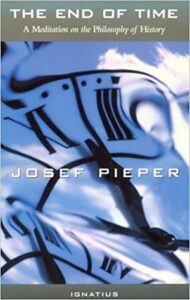 The End of Time: A Meditation on the Philosophy of History
The End of Time: A Meditation on the Philosophy of History
by Josef Pieper
Ignatius Press, San Francisco, California
ISBN 0-89870-726-9
ABOUT THE BOOK OF REVELATION This short work by Josef Pieper, a Catholic philosopher considered by many scholars to be among the most brilliant commentators on the thought of St. Thomas Aquinas, looks at the end of time from the two perspectives of philosophy and theology. The content is well worth the effort, but expect the occasional need to refer to a dictionary. Pieper’s comments about the relationship between the present day and the end of time make frequent reference to the book of Revelation, and they are in line with Catholic interpretation. Pieper concludes his work with heavy emphasis on the importance of witness, which he calls “blood-testimony.”
“The Christian notion ‘Dominion of the Antichrist’ is, moreover, not intelligible if it is not simultaneously conceived that original sin has been vanquished by the Logos become man, who eo ipso is also simultaneously the vanquisher of the Antichrist. We understand nothing about the Antichrist if we do not see him, despite all his power within history, as one who is fundamentally already defeated.”
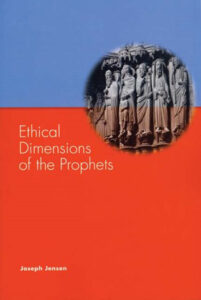 Ethical Dimensions of the Prophets
Ethical Dimensions of the Prophets
by Joseph Jensen
The Liturgical Press, Collegeville, Minnesota
ISBN 978-0-8146-5983-0
ABOUT THE PROPHETS Joseph Jensen’s scholarly book provides a response to the notion that the Old Testament prophets are irrelevant in our own time. The author examines how their forceful role in shaping the ethics of ancient Israel still strongly influences present-day ideas of social justice. The work focuses on the theological foundation of the ethical teachings of the prophets, especially their understanding of God. Reflecting on the teachings of the prophets offers rewards as well as challenges.
“What the prophet can conceive of as God’s will is something we can work for as a goal. While the United Nations exists in order to bring about peace among nations, its success depends upon the will of the nations to live in peace; the desire of an individual nation to live at peace with others will often depend on the will of its citizens to live at peace with one another. The beating of swords into plowshares, we might say, begins in our own back yard. … The concern for the poor and downtrodden that so characterized Amos and other prophets, if it became the moving force of individuals and states, could ultimately eliminate the conditions that promote violence and would therefore make the longed-for peace possible “
Explori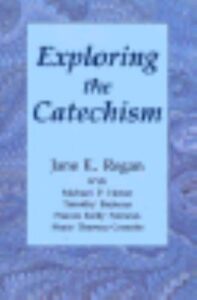 ng the Catechism
ng the Catechism
by Jane E. Regan with Michael P. Horan,
Timothy Backous, O.S.B., Francis Kelly Nemeck, O.M.I.,
and Maria Theresa Coombs
The Liturgical Press, Collegeville, Minnesota
ISBN 0-8146-2152-X
ABOUT THE CATECHISM This book, which carries an imprimatur, examines the Catechism of the Catholic Church from three different angles—the history of how catechisms have been used within the Church, how this particular Catechism can be used to enhance catechesis in individual parishes, and how the documents of the Second Vatican Council have shaped theological content of this Catechism. After setting the Catechism in context of its historical background, themes and issues of each of the four sections of the Catechism are addressed in ways that professional catechists will find especially helpful.
“As a map, the Catechism situates our journey of faith within the context of those who have gone before us. The long tradition of those who have known the mystery of God’s love and have struggled to put that into words are expressed for us today in the Catechism. While each generation, each group of believers must take the journey of faith for themselves, the text provides some clear markings to set out the right path. The Catechism also gives some clear boundaries about who God is, who Jesus is, and who human beings are.”
Faith and Certitude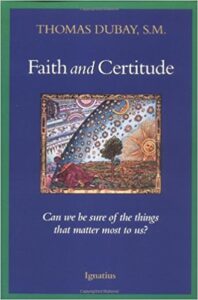
by Thomas Dubay, S.M.
Ignatius Press, San Francisco, California
ISBN 0-89870-054-X
ABOUT FAITH Known for his well-organized, inspirational, and sometimes humorous writing style, the author, a Marist priest, tackles critical contemporary issues concerning faith and certitude, cutting through the relativism and skeptical atmosphere of our time to expose the deepest roots of error, whether scientific or theological. His book can serve as an invaluable aid to anyone committed to an honest search for religious truth.
“Saints are never bored. A worldly person may be surprised at this statement and cast it aside as absurd. But the fact remains. Heroically good men and women do ‘rejoice in the Lord always.’ Though they suffer as much as the rest of us, and sometimes more than most of us, they are the most joyful people on earth.”
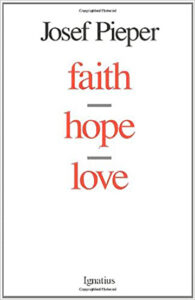 Faith Hope Love
Faith Hope Love
by Josef Pieper
Ignatius Press, San Francisco, California
ISBN 0-89870-623-8
ABOUT FAITH, HOPE & LOVE This volume contains separate treatises on the theological virtues of faith, hope, and love. Written by one of the most popular Thomist philosophers of the 20th century, the “faith” section of Faith Hope Love is derived from a series of lectures given in the late 1950s and early 1960s. The author relies heavily on his understanding of language—both root meanings as well as unexpressed but intuitively grasped hidden meanings. Excellent as a stand-alone work, “faith” forms a rock-solid foundation for understanding the author’s other works included on “hope” and “love.”
“In all belief the person of the witness is ‘the main thing’; and each person’s apprehension has its special modes, just as the decision on belief always has its place in the personal history of the believer himself. Thus it can happen that one man, while contemplating the cathedral of Rouen, is suddenly flooded with the certainty that this ‘fullness’ must be the sign of divine revelation; while another, as Simone Weil reports concerning herself, may accept the truth of Christ on the simple evidence of the rapture flooding the face of a young communicant. Who is to pass judgment on the legitimacy of such ‘arguments’?”
Fathers of the Church on Mary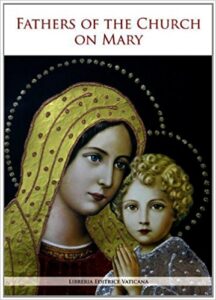
by Marco Pappalardo
United States Conference of Catholic Bishops, Washington, D.C.
ISBN: 978-1-60137-149-2
ABOUT THE BLESSED VIRGIN MARY The author’s stated purpose in writing this small book is “to get the Fathers out of the libraries or the patristic anthologies in order to present them to all, including those who are not specialists, scholars, or enthusiasts.” Each one of the 31 patristic quotes in the book features an introduction designed to set the stage for understanding the original Marian reflection. The writings of these ancient Fathers are considered to be one of the treasures of Church tradition, and they include this commentary written by St. Augustine on the Gospel According to John:
“Why therefore [at Cana] did the Son say to the mother: ‘What have I to do with you, woman? My hour has not yet come?’ Our Lord Jesus Christ was God and man; as God, he did not have a mother; as man, he did. She was therefore the mother of his flesh the mother of his humanity, the mother of the infirmity that he made his own for our sake. …With that response, therefore, the Lord intends to distinguish, in the faith of believers, who he is and how he came. He came by means of a woman, who is his mother, he who is God and Lord of heaven and earth. … He is, at the same time, Mary’s Lord and Mary’s Son. Do not be amazed that he is, at the same time, Son and Lord: He is called Son of Mary as he is also called Son of David, and he is Son of David because he is Son of Mary.”
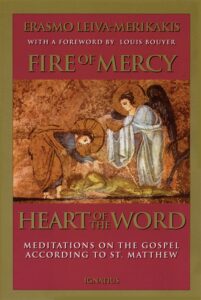 Fire of Mercy, Heart of the Word
Fire of Mercy, Heart of the Word
by Erasmo Leiva-Merikakis
Ignatius Press, San Francisco, California
ISBN 0-89870-558-4 (first of four books)
ABOUT THE GOSPEL ACCORDING TO MATTHEW In four volumes about the Gospel According to Matthew, the author of Fire of Mercy, Heart of the Word, a scholar of Greek, has applied the principles of lectio divina and faithfully recorded the results. His prayerful reading of Scripture in the language of the oldest available manuscripts has yielded a collection of personal insights with more intellectual depth than most contemporary reflections, yet less fact-focused than the usual approaches to Bible commentary. In his 30-page Introduction, the author describes the free rhythm of lectio divina in terms of fire and heart, and he focuses especially on the language of Scripture. The four volume series took 27 years to complete.
“In the Bible, as in all authentic poetry, the words themselves not only refer to the realities they signify but, like sacraments, themselves possess a reality of their own. This accounts for the element of surprise that everywhere in the Sacred Book is laying an ambush for our rationalism. Neither what God tells us about himself nor the manner in which he says it could have been guessed in advance by any deductive or inductive process. God is continually uttering the ineffable in Scripture. The weight of this ineffable utterance threatens to crack open the vessel that contains it.”
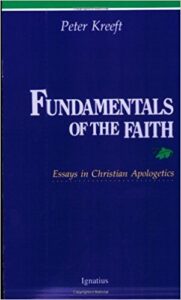 Fundamentals of the Faith:
Fundamentals of the Faith:
Essays in Christian Apologetics
by Peter Kreeft
Ignatius Press, San Francisco, California
ISBN 0-89870-202-X
ABOUT FAITH Using the three aspects of religion—belief, duty, and liturgy—the author explains and defends the fundamental truths of Christianity and Catholicism. The book begins with reasons for believing in God and moves on to basic issues of faith involving Jesus Christ. It includes comparisons of Christianity with other world religions, an in-depth look at the Apostles’ Creed and the Lord’s Prayer, and discussions of the four ‘last things,’ the theological virtues, and the marks of the Church. This book is an excellent resource for use during the initial inquiry portion of the Rite of Christian Initiation of Adults (R.C.I.A.), and a useful aid for any Catholic interested in apologetics.
“And that is the point of the creeds: truth. In fact, Primal Truth, the truth about God. That is why the words of the Creed are sacred words. Just as God’s material houses are sacred, so are his verbal houses. Of course God is no more confined to words, even the sacred words of creeds, than he is confined to the sacred buildings of tent or temple, church, or cathedral. But both are holy, set apart, sacred. ‘Thou shalt not take the name of the Lord thy God in vain.'”
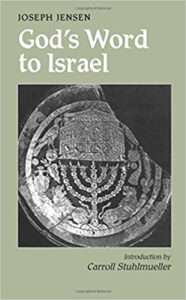 God’s Word to Israel
God’s Word to Israel
by Joseph Jensen
The Liturgical Press, Collegeville, Minnesota
ISBN 0-8146-5289-1
ABOUT THE PROPHETS & THE OLD TESTAMENT Although intended as a college textbook, this work by Joseph Jensen is more easily digested than Ethical Dimensions of the Prophets (see above). God’s Word to Israel will serve as a boon companion for anyone approaching the Old Testament with the aim of learning more about what it is that God is saying to humanity. The author is well aware that reading his introduction to the Old Testament is in no way a substitute for reading God’s Word. Jensen’s book provides background for additional reflection after first reading the Scriptures.
“The central message of the New Testament is that the redemption which Israel had long expected has at last been accomplished. The events by which God called Israel, formed its expectation, and brought this expectation to fulfillment, make up the message contained in the Bible—not a list of dry propositions, not a compilation of abstract truths, but a series of events which take place in human history. The events by which God is believed to have revealed himself and his plan for the redemption of fallen mankind is often called “salvation history” (Heilsgeschichte). The term supposes a God who is truly the Lord of history and whose will is to save.”
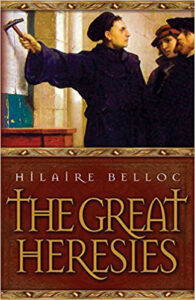 The Great Heresies
The Great Heresies
by Hilaire Belloc
Cavalier Press, Milwaukee, Wisconsin
ISBN 13-978-0-9915606-7-7
ABOUT CHURCH HISTORY In his book The Great Heresies. Hilaire Belloc, the English Catholic historian and contemporary of G.K. Chesterton, looks at the five main threats to Christianity and explains key related events in history from the perspective of a Catholic worldview, something frequently absent in other histories. Although most often referred to in connection with his writing about Islam, Belloc considered four other major threats to the Catholic faith: the Arian heresy, the Albigensian attack, the Protestant Reformation, and what he called “the modern phase” in which Belloc endorses the view that there’s no single antichrist, but rather that we’re living in an anti-Christian culture.
“It is often said that all heresies die. This may be true in the very long run, but it is not necessarily true within any given period of time. It is not even true that the vital principle of a heresy necessarily loses strength with time. The fate of the various heresies has been most various; and the greatest of them, Mohammedanism, is not only still vigorous but is more vigorous over the districts which it originally occupied than is its Christian rival, and much more vigorous and much more co-extensive with its own society than is the Catholic Church with our Western civilization which is the product of Catholicism.”
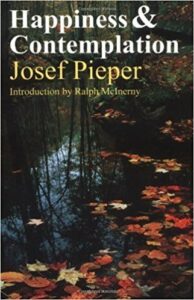 Happiness and Contemplation
Happiness and Contemplation
by Josef Pieper
St. Augustine’s Press, Inc., South Bend, Indiana
ISBN 1-890318-31-0
ABOUT THE SPIRITUAL LIFE The premise of Happiness and Contemplation is that the ultimate human happiness is to be found in contemplation. An examination of exactly what it means to pursue happiness leads the author, a Christian philosopher perhaps best known for his works on the theological and cardinal virtues, to profound conclusions about the nature of contemplation and the meaning of life.
“The happiness of contemplation is not a comfortable happiness. The great Spanish mystic, Teresa of Avila, has asserted that more courage is required to lead a life of contemplation than to elect martyrdom. And the references to the ‘dark night’ recur time and again in all spiritual doctrines of the vita contemplativa; this, it would seem, is an inescapable phase of the contemplative life.”
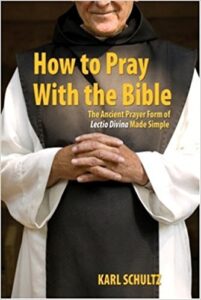 How to Pray with the Bible:
How to Pray with the Bible:
The Ancient Form of Lectio Divina Made Simple
by Karl A Schultz
Our Sunday Visitor, Huntington, Indiana
ISBN 978-1-59276-216-3
ABOUT LECTIO DIVINA How to Pray with the Bible: The Ancient Form of Lectio Divina Made Simple is a book that lives up to its title. The author has organized a wealth of information into a user-friendly format that allows readers easily to skip from one section of the book to another. Each chapter contains numerous subheads, sidebars, charts, lift-outs, and prayer tips. The simplicity of the format doesn’t translate into a shallow or light-weight approach to content, however. The author retains a strong feeling for the deep and mysterious nature of his topic.
“Lectio divina is distinguished by its relative imperviousness to time; like lovers, we linger with God and focus on our partner and the moment rather than the constraints of time. Love and spirituality have a timelessness and liberty in the Spirit that open us to new possibilities, including the suffering that accompanies all authentic relationships.”
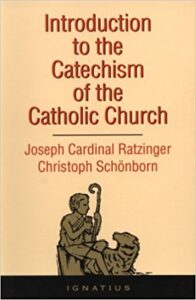 Introduction to the Catechism of the Catholic Church
Introduction to the Catechism of the Catholic Church
by Pope Emeritus Benedict XVI and Christoph Cardinal Schonborn
Ignatius Press, San Francisco, California
ISBN 0-90870-485-5
ABOUT THE CATECHISM Written by the two men who shaped the final form of the Catechism of the Catholic Church, this small book is divided into two sections. In the first, Pope Benedict XVI writes about the history behind the Church’s creation of this universal Catechism, and about the basic structure and content of the work. The second section, written by Christoph Cardinal Schonborn, deals with major themes and underlying principles of the Catechism and includes an overview of each of its four parts. In his section, Pope Benedict XVI directly addresses the issue of the authority of the Catechism of the Catholic Church.
“What significance the Catechism really holds for the common exercise of teaching in the Church may be learned by reading the Apostolic Constitution Fidei depositum, with which the Pope [Blessed John Paul II] promulgated it on October 11, 1992—exactly 30 years after the opening of the Second Vatican Council: ‘I acknowledge it [the Catechism] as a valid and legitimate tool in the service of ecclesiastical communion, as a sure norm for instruction in the faith.’ The individual doctrines which the Catechism presents receive no other weight than that which they already possess. The weight of the Catechism itself lies in the whole. Since it transmits what the Church teaches, whoever rejects it as a whole separates himself beyond question from the faith and teaching of the Church.”
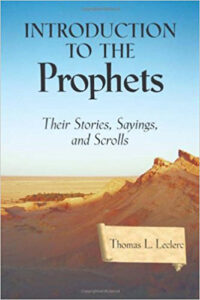 Introduction to the Prophets: Their Stories, Sayings and Scrolls
Introduction to the Prophets: Their Stories, Sayings and Scrolls
by Thomas L. Leclerc
Paulist Press, New York, New York / Mahwah, New Jersey
ISBN 978-0-8091-4492-1
ABOUT THE PROPHETS More accessible and more comprehensive than many books about the prophets, this introduction includes information about each of the prophetic books of the Old Testament as well as mention of the prophets found in the Pentateuch (the first five books of the Old Testament) and the historical books. The author compares the work of the prophets of Israel— always recognized as divine spokesmen—with pagan prophetic literature written at the same time in neighboring nations.
“Prophets straddle two worlds. On the one hand, they make the audacious claim to speak for God. As such, they think of themselves and are perceived by others as individuals sent from God with a message for God’s people. As messengers of God, they claim access to a world not generally available to other men and women. … On the other hand, prophets are entirely human men and women, shaped by their world and bound by their own time and culture. As human agents of God, their worldview and their words, their manner of speaking and ways of acting, their place in society, and their understanding of domestic and foreign politics are all influenced by their time and place in the world.”
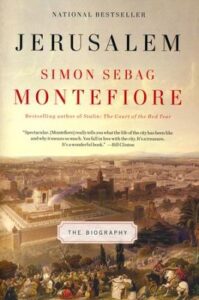 Jerusalem: The Biography
Jerusalem: The Biography
by Simon Sebag Montefiore
Alfred A. Knopf, New York
ISBN: 978-0-307-26651-4
ABOUT THE HOLY CITY The title Jerusalem: The Biography says it all. Simon Sebag Montefiore has written  a prize-winning work of non-fiction that looks at the Holy City’s 3,000 years of frequently unholy history through the viewpoint of Jews, Christians, and Muslims. A seriously ambitious work, this lengthy book (650 pages) treats the city of David as the primary character in a gripping narrative of the location often referred to as the “center of the world.” Jerusalem: The Biography is of particular relevance to any study of the life of David and his successors. The book opens by recounting the Roman attack on the city in 70 A.D., followed by an intensive look at Jewish control of Jerusalem beginning with David’s conquest of the citadel of Zion. At that time, the well-fortified Jebusite stronghold already was considered ancient. Sections on the Christian and Muslim influences on the Holy City follow. Present-day political leaders see Jerusalem as key to peace in the Middle East.
a prize-winning work of non-fiction that looks at the Holy City’s 3,000 years of frequently unholy history through the viewpoint of Jews, Christians, and Muslims. A seriously ambitious work, this lengthy book (650 pages) treats the city of David as the primary character in a gripping narrative of the location often referred to as the “center of the world.” Jerusalem: The Biography is of particular relevance to any study of the life of David and his successors. The book opens by recounting the Roman attack on the city in 70 A.D., followed by an intensive look at Jewish control of Jerusalem beginning with David’s conquest of the citadel of Zion. At that time, the well-fortified Jebusite stronghold already was considered ancient. Sections on the Christian and Muslim influences on the Holy City follow. Present-day political leaders see Jerusalem as key to peace in the Middle East.
“David chose this stronghold for his capital because it belonged neither to the northern tribes nor to his own southern Judah. He brought the golden shields of his conquered enemies to Jerusalem, where he built himself a palace, importing cedar wood from his Phoenician allies in Tyre. David is said to have conquered a kingdom that stretched from Lebanon to the borders of Egypt, and eastwards into today’s Jordan and Syria, even placing a garrison in Damascus. Our only source for David is the Bible: between 1200 and 850 B.C., the empires of Egypt and Iraq were in eclipse and left meagre royal records, but they also left a power vacuum. David certainly existed: an inscription found in 1993 at Tel Dan in northern Israel dating from the ninth century B.C. shows that the kings of Judah were known as the House of David, proving that David was the kingdom’s founder.
“Yet David’s Jerusalem was tiny. At this time, the city of Babylon, in today’s Iraq, covered 2,500 acres; even the nearby town of Hazor covered 200. Jerusalem was probably no more than 15 acres, just enough to house about 1,200 people around the citadel. But the recent discoveries of fortifications above the Gihon Spring prove that David’s Zion was much more substantial than previously though, even if it was very far from an imperial capital. …”
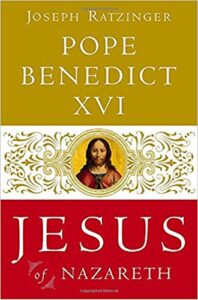 Jesus of Nazareth:
Jesus of Nazareth:
From the Baptism in the Jordan to the Transfiguration
by Pope Benedict XVI
Random House, Inc., New York
ISBN: 978-0-385-52341-7
 ABOUT JESUS’ MINISTRY This book in a three-part series about Jesus written by Pope Benedict XVI examines the Gospel descriptions of Jesus’ life on earth between his Baptism in the Jordan and the Transfiguration. Details related to his birth are covered in Jesus of Nazareth: The Infancy Narratives, and those related to his Passion covered in Jesus of Nazareth: Holy Week. All three volumes focus extensively on information found in the four Gospels; the author offers explanations to clarify discrepancies in the biblical source material.
ABOUT JESUS’ MINISTRY This book in a three-part series about Jesus written by Pope Benedict XVI examines the Gospel descriptions of Jesus’ life on earth between his Baptism in the Jordan and the Transfiguration. Details related to his birth are covered in Jesus of Nazareth: The Infancy Narratives, and those related to his Passion covered in Jesus of Nazareth: Holy Week. All three volumes focus extensively on information found in the four Gospels; the author offers explanations to clarify discrepancies in the biblical source material.
“The conclusion of [the book of] Deuteronomy returns to the promise and gives it a surprising twist that takes it far beyond the institution of prophecy. In so doing, it gives the figure of the prophet its true meaning. ‘And there has not arisen a prophet since in Israel like Moses,’ we read, ‘whom the LORD knew face to face (the book of Deuteronomy 34:10).’ A curious melancholy hangs over this conclusion of the fifth Book of Moses. The promise concerning ‘a prophet like me’ has not yet been fulfilled. And it now becomes clear that these words do not refer simply to the institution of prophecy, which in fact already existed, but to something different and far greater: the announcement of a new Moses. It had become evident that taking possession of the land in Palestine did not constitute the chosen people’s entry into salvation; that Israel was still awaiting its real liberation; that an even more radical kind of exodus was necessary, one that called for a new Moses.”
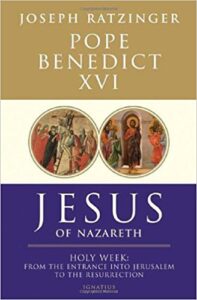 Jesus of Nazareth: Holy Week
Jesus of Nazareth: Holy Week
by Pope Benedict XVI
Random House, Inc., New York
ISBN: 978-0-58617-500-9
 ABOUT JESUS’ PASSION This book in a three-part series about Jesus written by Pope Benedict XVI examines the Gospel descriptions of Jesus’ last week on earth. The author regards this period of Jesus’ life as the time focusing most intently on the decisive sayings and events of Jesus’ life. As such, Jesus of Nazareth: Holy Week can be helpful to all readers who seek to encounter Jesus and to believe in him. All three volumes of this series focus extensively on information found in the four Gospels; the author offers explanations to clarify discrepancies in the biblical source material.
ABOUT JESUS’ PASSION This book in a three-part series about Jesus written by Pope Benedict XVI examines the Gospel descriptions of Jesus’ last week on earth. The author regards this period of Jesus’ life as the time focusing most intently on the decisive sayings and events of Jesus’ life. As such, Jesus of Nazareth: Holy Week can be helpful to all readers who seek to encounter Jesus and to believe in him. All three volumes of this series focus extensively on information found in the four Gospels; the author offers explanations to clarify discrepancies in the biblical source material.
“In recent theology, there have been many serious attempts, based on Jesus’ cry of anguish, to gaze into the depth of his soul and to understand the mystery of his person in his final agony. Ultimately, all these efforts are hampered by too narrowly individualistic an approach. … Even in the days of the Old Covenant, those who prayed the Psalms were not just individual subjects, closed in on themselves. To be sure, the Psalms are deeply personal prayers, formed while wrestling with God, yet at the same time they are uttered in union with all who suffer unjustly, with the whole of Israel, indeed with the whole of struggling humanity, and so these Psalms always span past, present, and future. They are prayed in the presence of suffering, and yet they already contain within themselves the gift of an answer to prayer, the gift of transformation.”
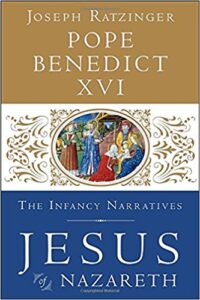 Jesus of Nazareth: The Infancy Narratives
Jesus of Nazareth: The Infancy Narratives
by Pope Benedict XVI
Random House, Inc., New York
ISBN: 978-0-385-34640-5
 ABOUT JESUS BIRTH This book in a three-part series about Jesus in the Gospels written by Pope Benedict XVI examines the infancy narratives pertaining to Jesus’ birth found in the Gospels According to Matthew and Luke, and also when relevant looks at how the Gospel According to John, which doesn’t include an infancy narrative, deals with questions surrounding Jesus’ lineage and how he came to be on earth in human form. All three volumes of this series focus extensively on information found in the four Gospels; the author offers explanations to clarify discrepancies in the biblical source material.
ABOUT JESUS BIRTH This book in a three-part series about Jesus in the Gospels written by Pope Benedict XVI examines the infancy narratives pertaining to Jesus’ birth found in the Gospels According to Matthew and Luke, and also when relevant looks at how the Gospel According to John, which doesn’t include an infancy narrative, deals with questions surrounding Jesus’ lineage and how he came to be on earth in human form. All three volumes of this series focus extensively on information found in the four Gospels; the author offers explanations to clarify discrepancies in the biblical source material.
“The Old Testament contains some passages that are still, as it were, ‘stray.’ Marius Reiser cites [the fifty-third chapter of the Book of Isaiah] as an example. One could relate the text to this or that figure, perhaps to Jeremiah. But the actual ‘owner’ of the text keeps us waiting. Only when he appears does the passage acquire its full meaning. The same applies, as we shall see, to [the Book of Isaiah] 7:14. This is another of the passages that, at the time of writing, were still waiting for the figure to whom they refer. One of the characteristics of early Christian narrative is that it provides these ‘waiting’ words with their ‘owner.’ The connection between the ‘waiting’ word and the recognition of its ‘owner,’ now that he has appeared, has given rise to the typically Christian approach to exegesis, which is new and yet remains utterly faithful to the original words of Scripture.”
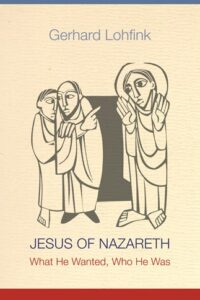 Jesus of Nazareth: What He Wanted, Who He Was
Jesus of Nazareth: What He Wanted, Who He Was
by Gerhard Lohfink
Liturgical Press, Collegeville, Minnesota
ISBN 978-0-8146-8058-2
A SCRIPTURAL PORTRAIT OF JESUS Gerhard Lohfink, a former professor of New Testament exegesis at the University of Tubingen in Germany, presents a profound and convincing and picture of Jesus based on passages from the four Gospels. Although the New Testament forms the basis for Lohfink’s work, the resulting portrait emphasizes Jesus’ Jewishness and his relationship to the history of Israel recorded in the Old Testament.
“It was not only in Nazareth that the ‘today’ of the Gospel was not accepted. Later also, in the course of the church’s history, it has again and again been denied or rendered toothless. The reason was the same as in Nazareth: Apparently it goes against the human grain for God to become concrete in our lives. Then people’s desires and favorite notions are in danger, and so are their ideas about time. It can’t be today, because that would mean that our lives have to change today already. Therefore God’s salvation is better delayed into the future. There it can lie, hygienically and snugly packed, at rest, inconsequential.”
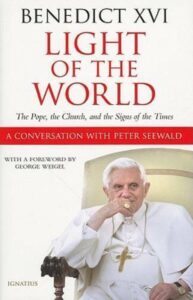 Light of the World: The Pope, the Church, and the Signs of the Times
Light of the World: The Pope, the Church, and the Signs of the Times
an interview by Peter Seewald
Ignatius Press, San Francisco, California
ISBN 978-1-58617-606-8
 POPE BENEDICT XVI In this rare and extended interview, which took place five years into his papacy, the pope discusses criticisms of his service as the Vicar of Christ, as well as the crisis in the Church brought on by the clergy sex abuse scandal, the need for Church reform, and the present-day problem of uniting faith and reason. A serious Scripture scholar, Pope Benedict XVI cites passages in both the Old and New Testaments to challenge readers—Catholics as well as others—to reconsider what they think they know about the Christian faith and about the future of the Church in our world.
POPE BENEDICT XVI In this rare and extended interview, which took place five years into his papacy, the pope discusses criticisms of his service as the Vicar of Christ, as well as the crisis in the Church brought on by the clergy sex abuse scandal, the need for Church reform, and the present-day problem of uniting faith and reason. A serious Scripture scholar, Pope Benedict XVI cites passages in both the Old and New Testaments to challenge readers—Catholics as well as others—to reconsider what they think they know about the Christian faith and about the future of the Church in our world.
“In keeping with man’s fallen nature, paganism breaks through in him again and again: This is an experience that runs through all the centuries. The truth of original sin in confirmed. Again and again man falls behind the faith and wants to be just himself again; he becomes a heathen in the most profound sense of the word. But again and again the divine presence in man becomes evident also. This is the struggle that passes through all of history. As Saint Augustine said: World history is a battle between two forms of love. Love of self—to the point of destroying the world. And love of others—to the point of renouncing oneself. This battle, which could always be seen, is in progress now, too.”
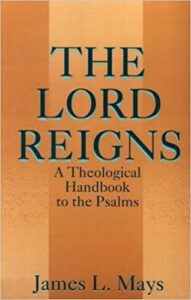 The Lord Reigns: A Theological Handbook to the Psalms
The Lord Reigns: A Theological Handbook to the Psalms
by James L. Mays
Westminster John Knox Press, Louisville, Kentucky
ISBN 0-644-25558-2
ABOUT THE PSALMS The author rather daringly and also convincingly makes the claim that all of the Psalms are united by a single theme, which is reflected in the title of his book. Mays traces the reign of God through the entire Book of the Psalms, providing readers with an interpretive framework that holds up equally well whether the Psalms are being used in liturgy, for personal prayer, or in Bible study. Although this book was written with academics in mind, the author’s straightforward writing style makes his ideas accessible to a larger audience.
“The Psalms were a primary context in the scriptures for the titles used to identify the role played by Jesus in God’s way with the world: King, Messiah, Son of God, Lord. But more important, the prayers in the Psalms furnish the signifying narrative motifs for the story of his Passion. In the story Jesus speaks their words, experiences their feelings, undergoes their sufferings. Given this relation between the self of Jesus and the text of the Psalms, it is no surprise that the Church saw reason in the Gospels to use the Psalms as its primal language of prayer and praise.”
The Love Tha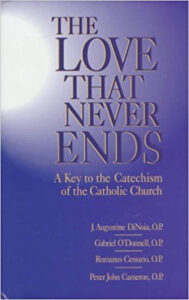 t Never Ends: A Key to the Catechism of the Catholic Church
t Never Ends: A Key to the Catechism of the Catholic Church
by J. Augustine DiNoia, O.P.,
Gabriel O’Donnell, O.P., Romanus Cessario, O.P., and Peter John Cameron, O.P.
Our Sunday Visitor, Huntington, Indiana
ISBN 0-879739852-9
ABOUT THE CATECHISM This helpful guide to the Catechism of the Catholic Church was written by four Dominican scholars. It takes its title from paragraph 25 of the book, a paragraph that develops the importance of charity. The theme comes from the preface to the previous Roman Cathecism, which emphasizes that whole concern of doctrine and its teaching must be directed to “the love that never ends. Whether something is proposed for belief, for hope or for action, the love of our Lord must always be made accessible, so that anyone can see that all the works of perfect Christian virtue spring from love and have no other objective than to arrive at love.” With love, the central mystery of the Christian faith, as their guiding light, the authors examine the underlying unity of the Catechism’s treatment of the Creed, sacraments, life in Christ, and prayer. The final chapters of The Love That Never Ends are devoted to prayer, and people interested in the practice of lectio divina should be especially interested in the authors’ discussion of contemplative prayer:
“It’s easy for us to side with a malcontent Martha over the seeming idleness of her sister Mary. And yet Jesus insists: ‘One thing only is required. Mary has chosen the better portion and she shall not be deprived of it’ (Luke 10:38-41). That one required thing, that better portion, is contemplative prayer.”
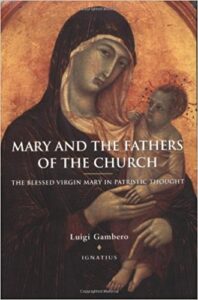 Mary and the Fathers of the Church:
Mary and the Fathers of the Church:
The Blessed Virgin Mary in Patristic Thought
by Luigi Gambero, S.M.
Ignatius Press, San Francisco, California
ISBN 0-89870-686-0
ABOUT THE BLESSED VIRGIN MARY Written by a patristics scholar, Mary and the Fathers of the Church offers a survey of the development of Marian doctrine and devotion to the Blessed Virgin during the first eight centuries of the Church, beginning with St. Ignatius of Antioch who was martyred at the end of the 1st century, and concluding with St. John Damascene, who died around 750. The book covers the formative period for the Church in the East and the West, and anyone interested in Church history will appreciate that it allows the patristic authors to speak in their own voices through excerpts from their works, some of which have not previously been published in English.
“The witness of the Fathers might give the impression that Marian doctrine and piety passed through a rather long and slow process of evolution. We must, however, recall that the times of the Lord’s grace are different from our own. The Lord knows how to adapt himself to the rhythms of the continual development of each individual and of humanity as a whole, and he awaits our answer with goodness and patience. Beneath the sobriety that veils the Marian doctrine of the earliest Fathers, the fertile seeds of future developments were planted, developments that profoundly influenced the Christian authors of the golden period of patristics as well as those of its closing years.”
Mary: Mirr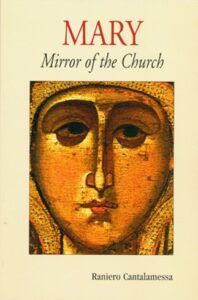 or of the Church
or of the Church
by Raniero Cantalamessa, O.F.M.
The Liturgical Press, Collegeville, Minnesota
ISBN 0-8146-2059-0
ABOUT THE BLESSED VIRGIN MARY This is an essential handbook for anyone struggling to understand the Blessed Virgin Mary and her place in contemporary Christianity. The author serves as preacher to the papal household, and his work is steeped in Scripture. He sidesteps the usual argumentative defense of Marian doctrine, and instead he looks at what can be learned about the Mother of Jesus from reading about her in the Bible.
“Mary appears as a sign of a Church not yet divided, not even in Jews and Gentiles, and therefore as the strongest possible call to unity. This ecumenical purpose we wish to follow is greatly favored by starting to study Mary from the Bible instead of starting with formal principles, theological theses, or the dogmas. The dogmas were formulated to explain the Bible and not vice versa. They are the exponent, not the basis. When dogma is the basis and Scripture the exponent, the dogmatic affirmation is placed first and biblical verses are used to demonstrate the argument, often far from the context and in a subordinate role as proof ex Scriptura. When Scripture is the basis, the starting point is God’s Word, and in expounding its meaning the dogma is reached as the true interpretation given by the Church. This is the way truth came down to us.”
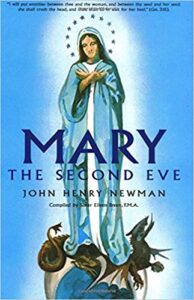 Mary: The Second Eve
Mary: The Second Eve
by Blessed John Henry Newman
TAN Books and Publishers, Inc., Rockford, Illinois
ISBN 0-89555-181-0
ABOUT THE BLESSED VIRGIN MARY Consisting entirely of excerpts from John Henry Cardinal Newman’s works, this small book demonstrates the insights and logic typical of this learned convert from Anglicanism who later became a Cardinal. Mary: The Second Eve is especially helpful for those who are looking for more information about the scriptural foundations of Marian doctrine.
“I grant that devotion toward the Blessed Virgin has increased among Catholics with the progress of the centuries. I do not allow that the doctrine concerning her has undergone a growth, for I believe that it has been in substance one and the same from the beginning.”
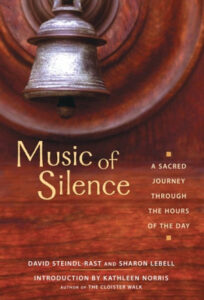 Music of Silence: A Sacred Journey through the Hours of the Day
Music of Silence: A Sacred Journey through the Hours of the Day
by David Steindl-Rast, O.S.B., and Sharon Lebell
Seastone, Berkeley, California
ISBN 1-56975-297-4
ABOUT THE PSALMS & LITURGY OF THE HOURS Are you looking for a way to add tranquility to your life without abdicating your responsibilities? The age-old monastic method of achieving serenity involves praying the Psalms at regular intervals throughout the day. While this isn’t practical for most of us, it is possible to incorporate a few minutes of silence and prayer into each day. This little book makes readers aware of the particular blessings associated with the traditional times for praying Liturgy of the Hours—Vigils, Lauds, Prime, Terce, Sext, None, Vespers, and Compline.
“The monastic venture is commonly misunderstood as an effort to be super-pious, to be more holy than other people. But he rationale for monasticism could be most succinctly described as an effort to live in the now. The monastery is a place in which everything is arranged so the it it made easy to be here now. And one way of achieving that is to follow the natural rhythm of the hours of the day. As a monk, ideally speaking, you always know what you are supposed to do at a given time. The moment when the bell rings for an activity, you drop whatever you have in your hands and turn to this new activity in readiness and responsiveness: because that hour is like an angel who calls you and challenges you and wants your response at that moment. Even though this is made easier in the monastery, the attitude behind it is something that people in any walk of life can attempt to realize. And, to the extent to which they realize it, it will make them happy.”
 Mysteries of the Virgin Mary: Living Our Lady’s Graces
Mysteries of the Virgin Mary: Living Our Lady’s Graces
by Peter John Cameron, O.P.
Servant Books, Cincinnati, Ohio
ISBN 978-0-86716-925-6
ABOUT THE BLESSED VIRGIN MARY Mysteries of the Virgin Mary approaches the task of increasing understanding of the theology behind Marian doctrine by looking at reasons behind each of the Marian feasts throughout the liturgical year. The author includes chapters about the Birth of Mary, her Presentation, her Immaculate Heart, her Holy Name, and her role as Queen of Heaven, and he examines her titles of Our Lady of Sorrows, Our Lady of Guadalupe, and, of course, Our Lady of the Rosary.
“Thus the aim of true devotion to the most Blessed Virgin is none other than to establish more perfectly the worship of Jesus Christ, and to provide an easier and safer way by which we can find Jesus Christ. ‘Devotion to the Blessed Virgin,’ St. Louis [de Montfort] insists, ‘is a secure way of reaching Jesus Christ and of acquiring perfection through uniting ourselves with him.’ Conversely, he holds that ‘one of the reasons why Jesus Christ is not known as he deserves to be known’ is because ‘Mary has been but very imperfectly known until now.’ In sum, ‘whoever desires to have the fruit of life, Jesus Christ, must have the tree of life, which is Mary.'”
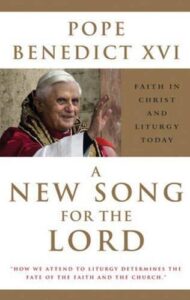 A New Song for the Lord: Faith in Christ and Liturgy Today
A New Song for the Lord: Faith in Christ and Liturgy Today
by Pope Benedict XVI
The Crossroad Publishing Company, New York, New York
ISBN 0–8245–1536–6
 LITURGY A New Song for the LORD: Faith in Christ and Liturgy Today combines Pope Benedict XVI’s interests in liturgy and music to challenge men and women’s understanding of God and the world and humanity’s relationship to Christ, the Church, and themselves. Although the author, a serious Scripture scholar, takes the phrase “sing a new song to the Lord” that appears throughout the Psalms as instructional for worship, he applies biblical principles to all forms of creativity and cites multiple passages from both Testaments.
LITURGY A New Song for the LORD: Faith in Christ and Liturgy Today combines Pope Benedict XVI’s interests in liturgy and music to challenge men and women’s understanding of God and the world and humanity’s relationship to Christ, the Church, and themselves. Although the author, a serious Scripture scholar, takes the phrase “sing a new song to the Lord” that appears throughout the Psalms as instructional for worship, he applies biblical principles to all forms of creativity and cites multiple passages from both Testaments.
“There is an art from corresponding to God, who, from the beginning and in each life, is the creative Word which also gives meaning. This art form stands under the primacy of logos; that is, it integrates the diversity of the human being from the perspective of this being’s highest moral and spiritual powers, but in this way it also leads the spirit out of rationalistic and voluntaristic confinement into the symphony of creation.”
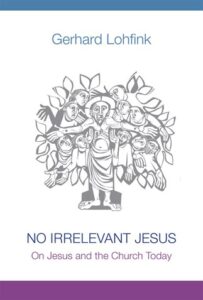 No Irrelevant Jesus: On Jesus and the Church Today
No Irrelevant Jesus: On Jesus and the Church Today
by Gerhard Lohfink
Liturgical Press, Collegeville, Minnesota
ISBN 978-0-8146-8264-7
ABOUT JESUS In this book of essays and talks, Gerhard Lohfink, a priest and former professor of New Testament exegesis at the University of Tübingen in Germany, addresses how present-day Christians water down who Jesus is and was, making Jesus and the Catholic Church seem irrelevant in the modern world. Lohfink discusses such challenging topics as “Jesus Revolutionizes Linear Time,” “Must the Pope Be Conservative?” and “Faith: How Does It Work?” It is of particular note that Lohfink strongly supports his points with references from both the Old and New Testaments, making this book and others by the same author valuable resources for any Catholics interested in serious Scripture study.
“Jesus is tamed and made irrelevant in a terrible way when we cease to speak about his imminent expectation. The same is true of a great many other aspects of his proclamation and his actions. … Jesus is rendered irrelevant when his preaching of judgment, which makes up a significant portion of the gospel tradition, is ignored and there is talk only of the loving and tender Jesus.”
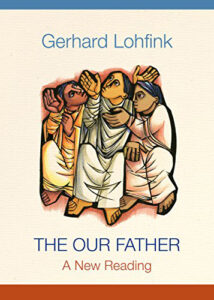 The Our Father: A New Reading
The Our Father: A New Reading
by Gerhard Lohfink
Liturgical Press, Collegeville, Minnesota
ISBN 978-0-81466-359-2
ABOUT PRAYER Without relying on excessive academic language, the author, a former professor of New Testament exegesis at the University of Tubingen in Germany, has produced an insightful and accessible commentary on the prayer known as the Our Father or the Lord’s Prayer. It is of particular note that Lohfink strongly supports his points with references from both the Old and New Testaments, especially the Gospels, the writings of the prophets, and the book of Exodus. Any Christian interested in abandoning a ho-hum approach to this frequently recited prayer can benefit from reading Lohfink’s short work, only 112 pages long.
“The Our Father is primarily a prayer for disciples. Every line is about disciples forgetting their own desires and plans for their lives and desiring only what God wills. In that sense it is a dangerous prayer for anyone who prays it. Far too often teh Our Father is misused, as a liturgical measure of time (‘Pause for the length of an Our Father’), or as a penance after confession (‘For your penance, say one Our Father and one Hail Mary’). … For us, the Our Father has often become routine. It is worn out. Its words and phrases are as blurred as a foggy landscape. ‘Hallowed be your name,’ ‘Your will be done’—it has all become vague. But on the lips of Jesus and in the ears of the disciples the Our Father had clear, sharply defined contours.”
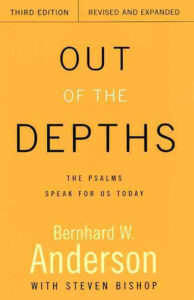 Out of the Depths: The Psalms Speak for Us Today
Out of the Depths: The Psalms Speak for Us Today
by Bernhard W. Anderson with Steven Bishop
Westminster John Knox Press, Louisville, Kentucky
ISBN 0-664-25832-8
ABOUT THE PSALMS With a title taken from the opening of Psalm 130 (which also is known in Latin as De Profundis), Anderson’s book focuses on the poetic forms of the Psalms as well as on their use in worship. The author includes in-depth commentary on several themes that reappear in the Psalms, addressing trials of faith, broken and contrite hearts, singing a new song, Creation, and the city of Zion. The author’s writing style is heavily academic with references that many lay people may find distracting.
“The Psalms bring us into God’s world, which often clashes with the marketing, materialistic, militaristic world in which, most of the time, we have our being. Biblical poets use human speech metaphorically to portray a world in which God is related covenantally to a people, Israel, and through them to all peoples. It is a world in which our relation to God, whether in times of divine presence or apparent absence, is expressed creatively in language of great power. It is no wonder, then, that down through the ages people have made the words of the Psalms their own. … The deep within the Psalms calls out to the deep within us. They articulate the human cry of every person ‘out of the depths.’”
 Pilgrim at Tinker Creek
Pilgrim at Tinker Creek
by Annie Dillard
Harper Collins, New York, New York
ISBN 978-0-06-095302-7
ABOUT INSPIRATION IN NATURE If you like to ponder the mysteries of the world that God has created, you might enjoy reading the Pulitzer Prize-winning book, A Pilgrim at Tinker Creek by Annie Dillard. A work of non-fiction, this beautifully written book focuses on an immense number of scientific peculiarities found during one year’s exploration of the natural environment surrounding a creek in Virginia. In these remarkable marvels of nature, the author sees undeniable evidence of God. This book can inspire readers to more closely examine similar natural evidence present in our own lives.
“All day long I walked among shifting color-patches that parted before me like the Red Sea and closed again in silence, transfigured, wherever I looked back. Some patches swelled and loomed, while others vanished utterly, and dark marks flitted at random over the whole dazzling sweep. But I couldn’t sustain the illusion of flatness. I’ve been around for too long. Form is condemned to an eternal danse macabre with meaning: I couldn’t unpeach the peaches. Nor can I remember ever having seen without understanding; the color-patches of infancy are lost. My brain then must have been smooth as any balloon. I’m told I reached for the moon; many babies do. But the color-patches of infancy swelled as meaning filled them; they arrayed themselves in solemn ranks down distance which unrolled and stretched before me like a plain. The moon rocketed away. I live now in a world of shadows that shape and distance color, a world where space makes a kind of terrible sense. What gnosticism is this, and what physics?”
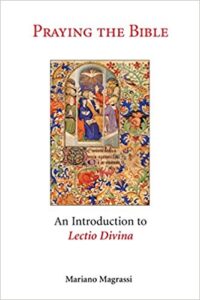 Praying the Bible: An Introduction to Lectio Divina
Praying the Bible: An Introduction to Lectio Divina
by Mariano Magrassi, O.S.B.
The Liturgical Press, Collegeville, Minnesota
ISBN 10-0-8146-2446-4
ABOUT LECTIO DIVINA Praying the Bible: An Introduction to Lectio Divina takes a scholarly approach to the topic and synthesizes the various aspects that make up the experience of lectio divina—what it is, its key ideas, the dispositions necessary for its practice, and the steps by which prayerful reading is transformed into genuine contemplation. The author intends his work to be an invitation to readers to delve more deeply into the practice of lectio divina. His chapter on concrete dispositions contains down-to-earth advice that includes practical cautions.
“Obviously, diligent and constant reading creates familiarity with the world of the Bible. But this does not come from a first reading. If a quick voyage of discovery is all we want, we will be disappointed. The beauty of this fascinating world will be hidden from us; upon entering it, we will feel as though everything is foreign. We cannot venture into the Bible as tourists; we must become inhabitants of the land. We need to retrace our steps, stop and reflect at each site in order to explore it in depth. To become part of this world we must enter it, immerse ourselves in it in order to be absorbed by it. Then it will reveal to us the charm of its secret places.”
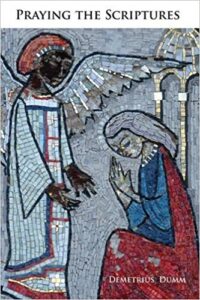 Praying the Scriptures
Praying the Scriptures
by Demetrius Dumm, O.S.B.
The Liturgical Press, Collegeville, Minnesota
ISBN 0-8146-2940-7
ABOUT LECTIO DIVINA Avoiding a step-by-step approach—and indeed even avoiding any mention of lectio divina— the author of Praying the Scriptures nevertheless has written a useful book devoted to explaining the practice in light of biblical revelation. Prayer primarily is seen as a celebration of God’s great saving deeds of the Exodus and the Resurrection—always pointing toward the sacrament of the Eucharist. The author also discusses attitudes to assist in developing a personal approach to reading and understanding the Bible.
“As a professor of Scripture in our seminary for more than fifty years, I have worked hard to help my students to understand the words of the Bible. I have given them regular examinations and graded them on the results. But it has always been somewhat frustrating not to be able to ask them the only question that really matters, which is: Has this knowledge of the Scriptures made a difference in your personal lives?”
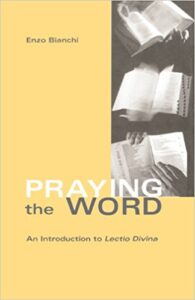 Praying the Word: An Introduction to Lectio Divina
Praying the Word: An Introduction to Lectio Divina
by Enzo Bianchi
Cistercian Publications, Kalamazoo, Michigan
ISBN 0-87907-682-8
ABOUT LECTIO DIVINA Praying the Word: An Introduction to Lectio Divina sets forth a collection of points designed to emphasize the importance of God’s Word. The author cautions against distortions and difficulties that can develop when lectio divina loses contact with Scripture—sentimental piety, dry theologizing and intellectual speculation, an overemphasis on secondary and derived aspects of the Christian message, hardening individualism, and a taste for novelty.
“The men and women who have visible roles of ministry in the Church must go to the Word, the source, through lectio divina. If they do not, they are liable to appear in their preaching, teaching and pastoral work as people who depend on manuals, people who rely on the sometimes groundless opinions of others, people who lack certainty and therefore see problems everywhere, people who are incapable of speaking a ‘strong’ word ‘with authority,’ but who instead speak as the scribes did in Jesus’ time (Matthew 7:28–29), people who blush at the Gospel they proclaim (Romans 1:16; 2 Corinthians 3:12; 4:2).”
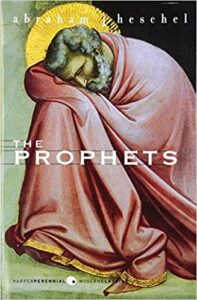 The Prophets
The Prophets
by Abraham Heschel
HarperCollins Publishers, New York, New York
ISBN 978-0-06-093699-0
ABOUT THE PROPHETS Although the prophets are essential to salvation history, a number of different ideas exist about their role. Abraham Heschel, a Jewish scholar, understands a prophet to be someone compelled to sympathize with God about humanity’s endangered access to eternal life. Heschel’s book is considered a seminal work by many biblical scholars, and it continues to exert great influence on how Christians as well as Jews view the Old Testament prophets.
“To a person endowed with prophetic sight, everyone else appears blind; to a person whose ear perceives God’s voice, everyone else appears deaf. No one is just; no knowing is strong enough, no trust complete enough. The prophet hates the approximate, he shuns the middle of the road. Man must live on the summit to avoid the abyss. There is nothing to hold to except God. Carried away by the challenge, the demand to straighten out man’s ways, the prophet is strange, one-sided, an unbearable extremist. … The prophet’s word is a scream in the night. While the world is at ease and asleep, the prophet feels a blast from heaven.”
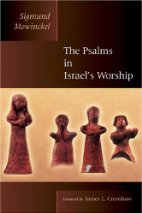 The Psalms in Israel’s Worship
The Psalms in Israel’s Worship
by Sigmund Mowinckel
William B. Eerdmans Publishing Company, Grand Rapids, Michigan
ISBN 0-8028-2816-7
ABOUT THE PSALMS Sigmund Mowinckel is widely regarded as a leading Old Testament scholar, and his book is considered foundational to serious modern study of the Psalms. Translated into English from Norwegian, this rather heavy book is aimed at an academic audience. Because Mowinckel’s influence is pervasive among Scripture scholars, most of his ideas can be found in other author’s works on the Psalms. Readers especially interested in the history of the Psalms as well as the Psalms’ original place in Israel’s liturgical practices may nevertheless want to tackle reading Mowinckel for themselves.
“The ancient Israelites did not shape their thoughts to the pattern of Christian dogmas and morals. Nor can a classification according to the religious ideas represented in the different Psalms be considered satisfacotry: We cannot be sure that the idea which to us seems most prominent was so for the poet. … There is not Psalm which does not accept God’s majesty and his power to intervene everywhere and all the time, or which does not acknowledge him as creator; the question is: Why does, e.g., this special Psalm speak at greater length and in more detail about Creation than is usual in the Psalms. … All this modern grouping only leads us to ask the poets about things which interest us, but to which they often have no answer; instead of trying to see things from their point of view, and asking what is in their mind.”
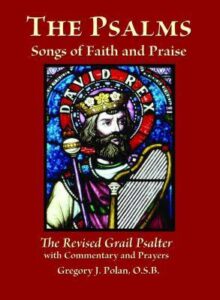 The Psalms: Songs of Faith and Praise
The Psalms: Songs of Faith and Praise
by Gregory J. Polan, O.S.B.
Paulist Press, New York, New York / Mahwah, New Jersey
ISBN 978-0-8091-4882-0
ABOUT THE PSALMS The Psalms: Songs of Faith and Praise is a valuable resource for anyone who wishes to learn more about praying with the Psalms. Benedictine Abbot Primate Gregory Polan, who also was the lead translator of The Revised Grail Psalms, has written a book that is less a how-to manual and more a demonstration of lectio divina in action. In addition to The Revised Grail Psalms, which is included in its entirety, Songs of Faith and Praise includes commentary and short prayers relating to each of the 150 Psalms. New Testament connections to the Psalms are emphasized in the commentary..
“We learn from the Psalms the language of prayer that has characterized both synagogue and church for centuries. Sometimes we may be surprised or even shocked at the imagery employed, so different from the way we tend to portray our own experience in today’s world. But by studying the context and meaning of those images and metaphors, we can come to see how even these images of violence and hostility, suffering and sadness, can speak to us as poetry imbued with the beauty of faith and hope. For example, when the Psalmist says that God is aware of our wanderings and collects our tears in a flask (Psalm 56:9), we are touched by this Hebraic image of tenderness; yes, God knows our every footstep; each tear of sadness and disapointment is collected and retained by the One who cares so deeply for us.”
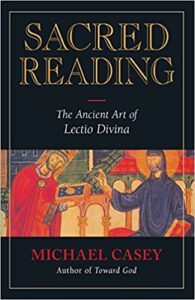 Sacred Reading: The Ancient Art of Lectio Divina
Sacred Reading: The Ancient Art of Lectio Divina
by Michael Casey
Ligouri Publishers, Ligouri, Missouri
ISBN 0-89243-891-6
ABOUT LECTIO DIVINA Used as a text by monastic novices, Sacred Reading offers an excellent introduction to lectio divina, examining the spirit and the theological basis of lectio divina as it developed in Western monasticism. The author draws on his experiences as a Cistercian monk to guide readers in their practice of lectio divina. Sacred Reading offers pointers for applying lectio divina to writings of the Fathers of the Church, and it includes as well a list of patristic texts suitable for lectio divina. Looking at The Rule of St. Benedict, the author focuses on what it means to be a pupil in the school of the Lord’s service in the contemporary world.
“Contact with God’s Word comes through the Church’s proclamation, through reading the Scriptures, and through the counsel of a graced elder. These conspire with deep inner processes to shape our conscience. Our willingness to listen and to be formed by God’s Word is what constitutes us as members of Christ’s school.”
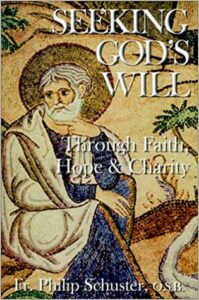 Seeking God’s Will Through Faith, Hope & Charity
Seeking God’s Will Through Faith, Hope & Charity
by Philip Schuster, O.S.B.
The Printery House, Conception Abbey, Conception, Missouri
ISBN: 0-9701865-2-5
ABOUT FAITH Written by a priest and Benedictine monk, this book is intended to serve as a practical guide for anyone who is sincere about wishing to respond to God in faith. The down-to-earth wisdom is suitable for people at all stages of the spiritual journey, and applies to lay men and women as well as religious.
“At present I feel that you can’t teach another how to pray. You can teach a child to say prayers, but that really isn’t praying. You can give some advice, a method of praying, to an adult. You can warn adults that they must do much more than say prayers. You can tell them things to do that will perhaps lead them to pray, but we learn how to pray by praying. Probably God teaches us.”
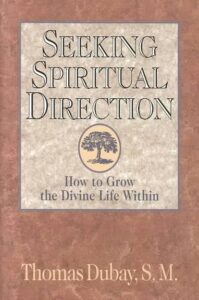 Seeking Spiritual Direction: How to Grow the Divine Life Within
Seeking Spiritual Direction: How to Grow the Divine Life Within
by Thomas Dubay, S.M.
Servant Publications, Ann Arbor, Michigan
ISBN 0-90293-810
ABOUT THE SPIRITUAL LIFE In one of the best books we’ve come across that addresses the practical ins and outs of discernment, the author begins by defining spiritual direction After establishing the things that constitute the need for spiritual direction, the remainder of the book is written in a question-and-answer format in which the author offers down-to-earth insights on the most common problems and concerns related to spiritual direction. This book is included among other selections about prayer because of the author’s heavy emphasis on the importance of prayer, especially contemplative prayer.
“Most of us possess only a dim awareness of the many subtle defects that dampen enthusiams and main full generosity. What we have in mind here is not a weak self-image, for that is based on unreality. Rather what we envision is the host of actual defects beginners commonly do not see in themselves: unrealized vanities, inclinations to laziness, idle talking, other useless ‘time killers’ and distractions, needless indulgences of the palate, cravings for human respect, resistance to correction, love for superfluities, reluctance to obey, a desire for artificial excitements and amusements. Without a living guide it is mighty hard to be aware of those facts, let alone overcome them. Furthermore, self-direction does not readily remedy simple mistakes or lack of information.”
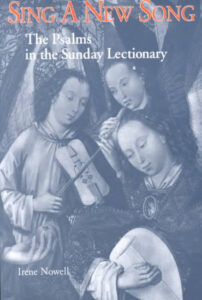 Sing a New Song: The Psalms in the Sunday Lectionary
Sing a New Song: The Psalms in the Sunday Lectionary
by Irene Nowell, O.S.B.
The Liturgical Press, Collegeville, Minnesota
ISBN 0-8146-2043-4
ABOUT PSALMS & LITURGY The Responsorial Psalm prayed as part of the Sunday Mass well may be the most neglected part of the Liturgy of the Word. In Sing a New Song: The Psalms in the Sunday Lectionary, Nowell expounds on the meaning and beauty of the individual Psalms, and comments on their relationship to the other readings. This book is an invaluable resource for anyone who wishes to be more engaged with the Mass readings, and especially for cantors, music directors, and R.C.I.A. catechists.
“[This book] is intended as a ministry to the imagination. It follows what Benedictines call the lectio approach. Images are pursued and linked. Connections are drawn because of the juxtaposition that would not be part of the analysis of any one of the readings. The liturgical sense of feast and season is also used to open further meanings. It is hoped, however, that no violence has been done to either Psalm or readings. The complex interweaving of liturgical readings forms, in the end, its own identity. It is this identity which the book explores.”
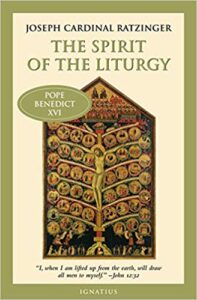 The Spirit of the Liturgy
The Spirit of the Liturgy
by Pope Benedict XVI
Ignatius Press, San Francisco, California
ISBN 978-1-62164-258-9
 ABOUT LITURGY Considered by devotees as one of Pope Benedict XVI’s greatest works, The Spirit of the Liturgy is aimed at helping readers deepen their understanding of the “great prayer of the Church.” Important themes dealt with are the essence of worship, the Jewish roots of Christian prayer, and the relationship of the liturgy to time and space. Of special interest is a discussion of the fundamental misunderstandings of the Second Vatican Council’s intentions for liturgical renewal. Included in this edition is an earlier work of the same name by Servant of God Romano Guardini that greatly influenced this book.
ABOUT LITURGY Considered by devotees as one of Pope Benedict XVI’s greatest works, The Spirit of the Liturgy is aimed at helping readers deepen their understanding of the “great prayer of the Church.” Important themes dealt with are the essence of worship, the Jewish roots of Christian prayer, and the relationship of the liturgy to time and space. Of special interest is a discussion of the fundamental misunderstandings of the Second Vatican Council’s intentions for liturgical renewal. Included in this edition is an earlier work of the same name by Servant of God Romano Guardini that greatly influenced this book.
“We have so far presented a sketch of the inner dynamism of the idea of worship in the Old Testament and have shown that there was an intense awareness of the impermanence of the Temple sacrifices together with a desire for something greater, something indescribably new. Before trying to pull everything together and draw some conclusions, we must try to hear the voices in which there is already a presentiment of this new thing that is to come. … In pre-exilic Israel, one constantly hears voices warning about the rigidifying of the sacrificial system and its degeneration into externalism and syncretism. The Exile came as a challenging opportunity to formulate clearly a positive doctrine about worship and the new thing that was to come.”
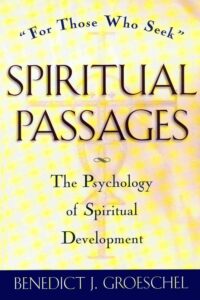 Spiritual Passages: The Psychology of Spiritual Development
Spiritual Passages: The Psychology of Spiritual Development
by Benedict J. Groeschel, C.F.R.
The Crossroad Publishing Company, New York, New York
ISBN 0-8245-0628-6
ABOUT THE SPIRITUAL LIFE Books that attempt to deal with the psychological dimension of spirituality are few and far between, and those that can be easily understood by the average lay reader are even more rare. In Spiritual Passages, the author addresses the important connection between psychology and spirituality, presenting practical information to serve as an aid to any serious endeavor toward developing spiritual maturity.
“When the call of God comes, it is abundantly clear that there is much work to be done. This is evident from our discussion concerning the particular aspect of God that speaks to us depending on our personality (the Four Voices of God), as well has what we have seen of the developmental needs of individuals, and the constant pull of pathology against our complete development. … In Christianity the development of the individual toward conformity with Absolute Being is not accomplished haphazardly. It can be achieved only the the grace of the Son of God and according to His teachings. Its dynamism derives not from some exotic array of divine-like qualities, but from adoption as children of God. The startling document called the Sermon on the Mount, which flows from the Law and yet transcends it, provides the foundation for the code by which the Christian must live.”
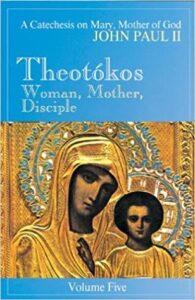 Theotokos: Woman, Mother, Disciple
Theotokos: Woman, Mother, Disciple
by Pope St. John Paul II
Pauline Books & Media, Boston, Massachusetts
ISBN 0-8198-7401-9
 ABOUT THE BLESSED VIRGIN MARY Based on talks by Pope St. John Paul II, volume five of this collection explores who the Blessed Virgin Mary is for Christians today. Other volumes in the set address God the Father, Jesus the Son, the Holy Spirit, and the Church. In explaining Marian doctrine, Pope St. John Paul II points out that everything about Mary is related to Christ and is intended to lead the faithful into deeper relationship with Jesus. The Mother of God appears as an example of faith and love, and a model of the Church at prayer.
ABOUT THE BLESSED VIRGIN MARY Based on talks by Pope St. John Paul II, volume five of this collection explores who the Blessed Virgin Mary is for Christians today. Other volumes in the set address God the Father, Jesus the Son, the Holy Spirit, and the Church. In explaining Marian doctrine, Pope St. John Paul II points out that everything about Mary is related to Christ and is intended to lead the faithful into deeper relationship with Jesus. The Mother of God appears as an example of faith and love, and a model of the Church at prayer.
“On the one hand, the Church recognizes the Theotokos as guaranteeing the reality of the Incarnation because—as St. Augustine says—’if the Mother were fictitious, the flesh would also be fictitious . . . and the scars of the resurrection.’ On the other hand, [the Church] also contemplates with wonder and celebrates with veneration the immense greatness conferred on Mary by the one who wanted to be her Son. The expression ‘Mother of God’ is used as referring to the Word of God, who in the Incarnation assumed the lowliness of the human condition in order to raise men to divine sonship. But in the light of the sublime dignity conferred on the Virgin of Nazareth, this title also proclaims the nobility of woman and her loftiest vocation. God treated Mary as a free and responsible person and did not bring about the Incarnation of his Son until after he had obtained her consent.”
